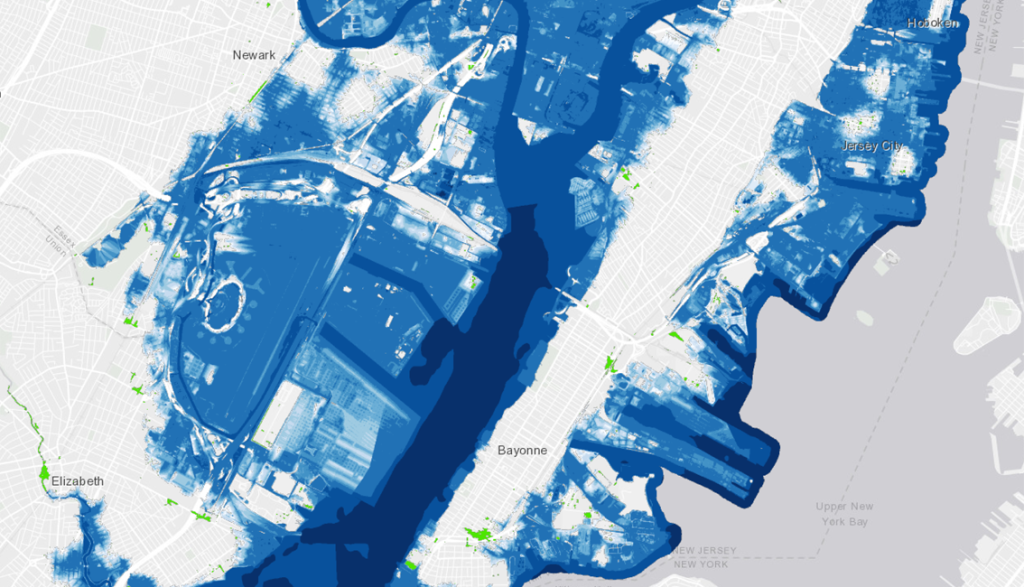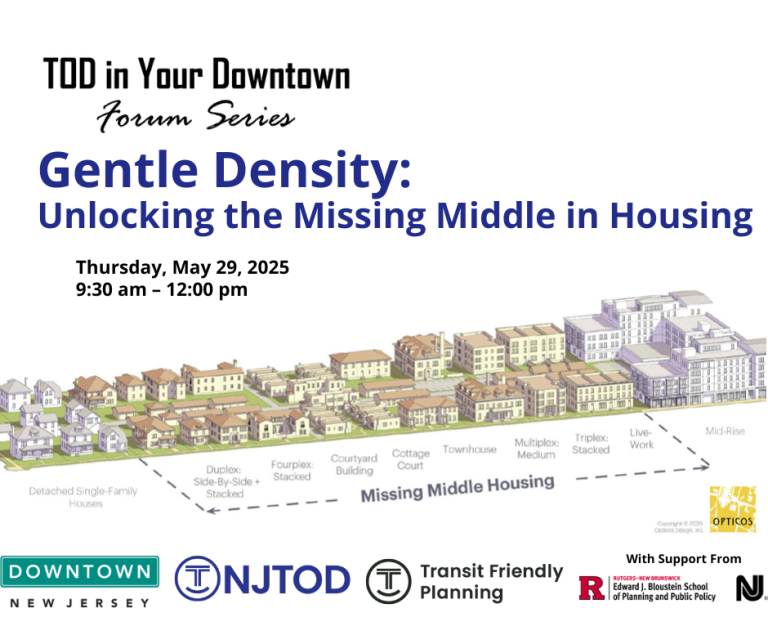This map portrays a 100 Year Storm after applying 5 ft. sea level rise, and reflects what the new regulated area would likely be under the PACT regulations.
What DEP’s Climate Rules Mean to Downtowns
By Grant Lucking
Chief Operating Officer, New Jersey Builders Association
March 1, 2023
On January 27, 2020, Governor Murphy signed Executive Order (EO) 100 directing the New Jersey Department of Environmental Protection (DEP) to develop the “Protecting Against Climate Threats” (PACT) regulations. DEP subsequently released Administrative Order 2020-01 identifying the Flood Hazard Area (FHA), Coastal Zone Management (CZM), Freshwater Wetlands (FWW), and Stormwater Rules, as well as “any other rules or guidance that address flood storage…” as those that DEP would amend per EO 100.
The New Jersey Builders Association (NJBA), representing the residential homebuilding industry in NJ, has been closely following the development of the PACT regulations, especially the section entitled Resilient Environment and Landscapes (REAL), which concern DEP’s Stormwater, FHA, CZM, and FWW rules.
Phase I
DEP has unveiled that the REAL rules will occur in two phases. The first, which was recently proposed, focuses on inland flooding and precipitation, while the second encompasses nearly every other aspect of DEP’s land use rules. The first portion of the REAL rules was slated to be proposed as an emergency rule in June 2022, before major concerns from the regulated community about limited grandfathering in the rule caused DEP to pause. (Emergency rules are effective the day they are filed.) Ultimately, DEP published the rule under its normal rulemaking process on December 5, 2022. The proposed Inland Flood Protection Rule takes the dramatic step of raising base flood elevations by two feet statewide, and requiring that stormwater designs meet DEP’s near worst-case-scenario (17th percentile chance of occurrence) precipitation projections for the year 2100.
The additional two feet of flood elevation, coupled with increased stormwater requirements, will pose development challenges for many communities in NJ. Of particular concern, the FHA rules contain a requirement to provide “dry access,” meaning both structures and connecting roadways that provide access need to be elevated above flood elevation. Proposed developments near waterways, particularly in low lying areas, may be able raise structures; however, the cost of raising roadways can easily make a project financially infeasible. At present, DEP has no set standard on how far away from a site a roadway needs to be raised before it is considered a hardship. No matter the distance, this could be particularly troublesome in downtowns whose structures are intentionally fronted near the road to create a sense of place. NJBA is concerned that this aspect of the FHA rules will discourage investment in areas where more resilient structures are most needed. Communities throughout NJ should evaluate the impact of the rule proposal on their zoning and redevelopment plans, though DEP has not provided updated mapping depicting the new flood zones.
Of particular concern to the development community is the rule proposal’s grandfathering provisions, which offer limited protection for projects in various phases of development. To reach legacy status under the stormwater rules, a project needs to have submitted a complete application to DEP for a permit under the Stormwater, FWW, CZM, or FHA rules, or in cases where DEP approval is not required, a complete application at the local level, prior to the rule’s adoption. The proposal’s grandfathering provisions under the FHA rules are even more limiting, requiring an application for an FHA permit or for an applicant to have all Federal, State and Local approvals and construction to have begun. Applicants who are unable to apply for an FHA permit, but will need one under the new rules, will likely need to reevaluate the feasibility of their projects if they are unable to rush to construction or are awaiting other development approvals.
NJBA identified numerous projects that would be affected by the limiting grandfathering provisions and is concerned that without a delayed implementation date, countless planning hours and investments may be lost as projects are forced back to the drawing board.
Phase II
DEP has announced the second portion of the REAL rules is targeted for proposal as soon as Spring 2023. The second portion of the rules is wide-ranging and is likely to alter most of DEP’s land use rules. In stakeholder presentations, DEP indicated that it intends to raise Coastal Flood Elevations to account for sea level rise. Like the Phase I Real rule, DEP has chosen to utilize a 17th percentile chance of occurrence for the year 2100, based on modeling produced by Rutgers University. This calculation will add 5 feet to coastal flood elevations, which when combined with DEP’s factor of safety of one foot, will result in flood elevations 6 feet above FEMA’s 100-year flood. The effect of this elevation increase cannot be understated as it will extend far beyond the coast as estuaries are also affected. Areas along NJ’s gold coast and the barrier islands can expect to see drastically changed Flood Hazard Areas.
In addition to the new coastal flood elevation, DEP is considering changes to its Stormwater and FWW rules. The most significant change would be a proposal requiring redevelopment to meet the same water quality standards as greenfield development, coupled with increased stormwater retention standards. Under the current Stormwater rules, redevelopment projects can count existing impervious coverage and are required to reduce Total Suspended Solids by 50% in stormwater runoff. The new standard would be substantially higher and could be a major disincentive to redevelopment, especially where large amounts of impervious surface exist.
Planners, developers, and downtown managers should be aware that DEP’s proposed rule changes will have dramatic consequences on development in NJ. NJBA appreciates that DEP is taking the important step to produce rules that reflect our changing climate and to foster resiliency in NJ. However, further conversations and planning should be conducted across government to evaluate the dramatic impact these rules may have on existing development and redevelopment plans. Given NJ’s severe shortage of market rate and affordable housing, incentives should be introduced to target growth in the right areas, to both balance the effect of the PACT rules and to ensure NJ creates a more resilient and healthy housing ecosystem.
Please feel free to contact NJBA with any questions at information@njba.org.
The New Jersey Builders Association (NJBA) is the leading trade association for the shelter industry in New Jersey. Members include residential and commercial builders, developers, remodelers, subcontractors, suppliers, engineers, architects, consultants and other professionals. NJBA serves as a resource for its members through continuing education and advocacy. NJBA and its members strive for a more vibrant, greener, and affordable housing market in New Jersey. The three-tiered membership structure of the Association provides its member’s representation and opportunity at the local, state, and national levels. Learn more about NJBA at www.njba.org, and follow us on Instagram, Facebook, LinkedIn, and Twitter.



